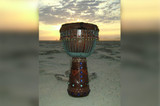The Conga Drum & Dance
The Conga, a dance involving a single-file chain of people roving around a room to the beat of a Conga drum and accompanying instruments, is an Afro-Cuban dance brought over by slaves and may be most famous for its appearance in movies, wedding receptions or its performance by Desi Arnaz in the 1950's. The Conga may have been a way for slaves to celebrate victories in their daily lives or surrepticiously express their anger, and has become a staple of parties, festivals and other celebrations like Carnivale. The dance first made its appearance in the United States in 1929 at The Conga night club and became wildly popular through its use in broadcasting, including this scene from Strike Up the Band starring Mickey Rooney and Judy Garland.
According to eHow.com, "Many Cuban slaves were from Africa's Congo region, and after slavery was abolished in Cuba, they shared their culture, including their drums, with Cuba. The Conga drum has experienced many changes over time in Cuba." Originally fashioned after the makuta, a drum hailing from the Congo region of Africa, modern Conga or Tumbadora drums have evolved from a cone-shape to the cylindrical shape we see today.
The Conga dance and its accompanying Conga drum can take any event or party and make it ridiculously fun and festive. For the timid and dance-shy, remember to “take small steps, one for each beat, and make sure your kick is to the side, not in front of you or in back. You don't want to kick the other people in the line." Whether you are a Conga drum player or a Conga dancer, the Conga is a time-honored tradition of celebration and fun. The Conga brings people together, giving them a reason to bust a move on the floor or pick up a drum to accompany the celebration of the dance, the drum, and its unique culture and traditions.
Read more about Congas, their history, the best brands and how to play congas.
Recent Posts
-
What is the Best Size Djembe for Beginners?
If you're new to the world of percussion and interested in learning the djembe, you're in for a t …16th Jul 2024 -
The Benefits of Becoming a Drumming Teacher: Transforming Passion into Profession
Why become a drumming teacher? Becoming a drumming teacher is an excellent way to share your pas …22nd May 2024 -
What Makes the Djembe Drum a Spiritual Instrument in African Music?
Origin and history of the Djembe drum The Djembe drum originates from West Africa and holds sign …16th May 2024



